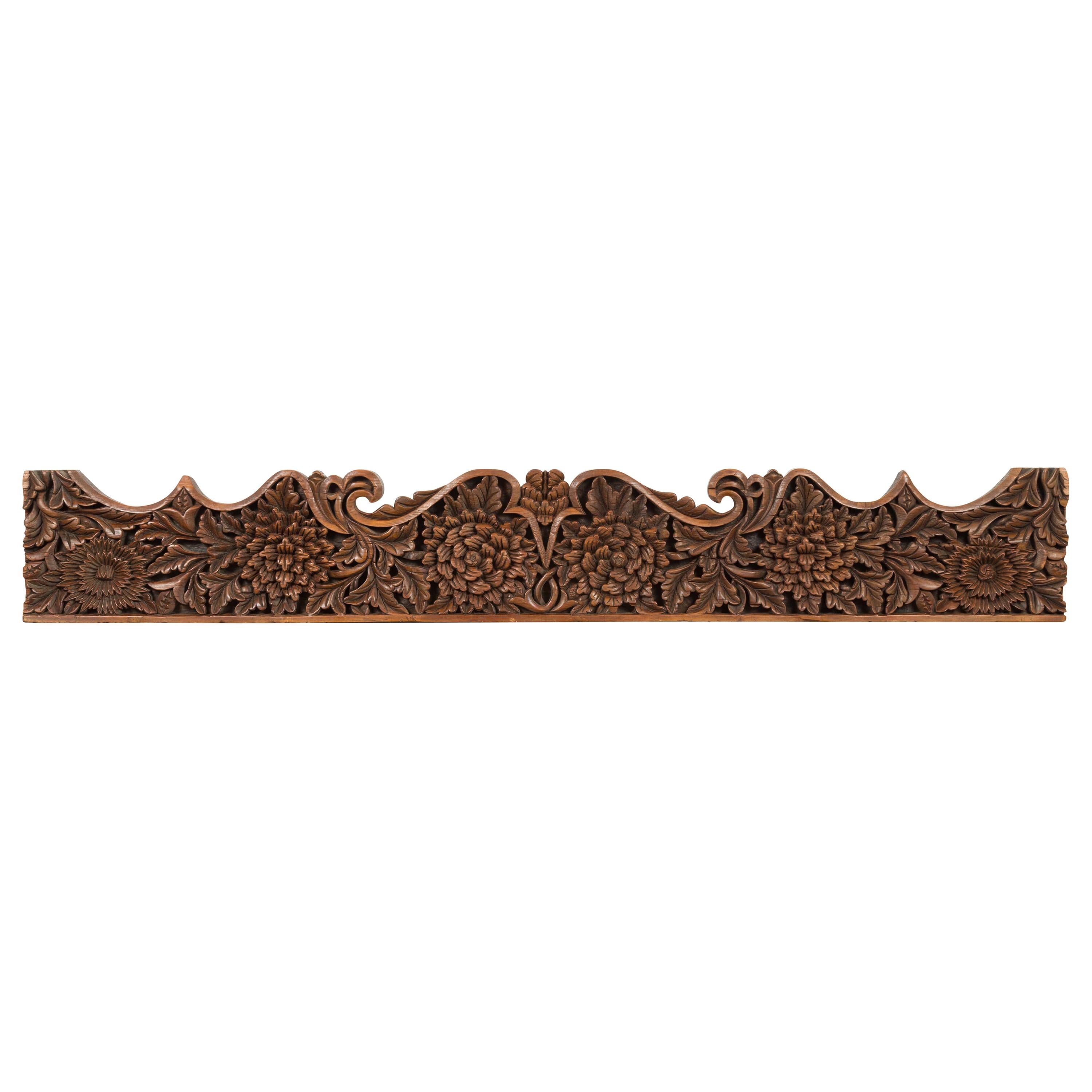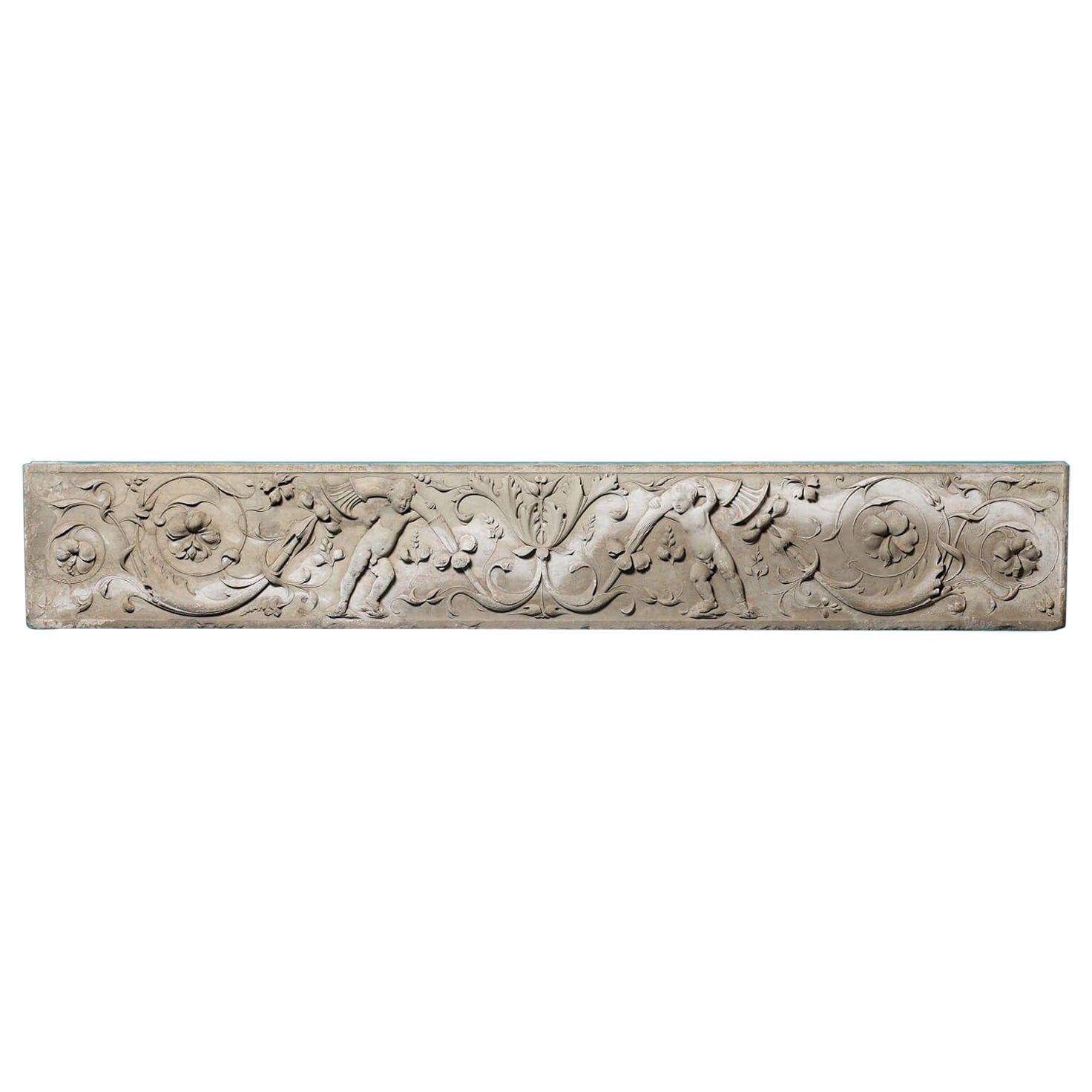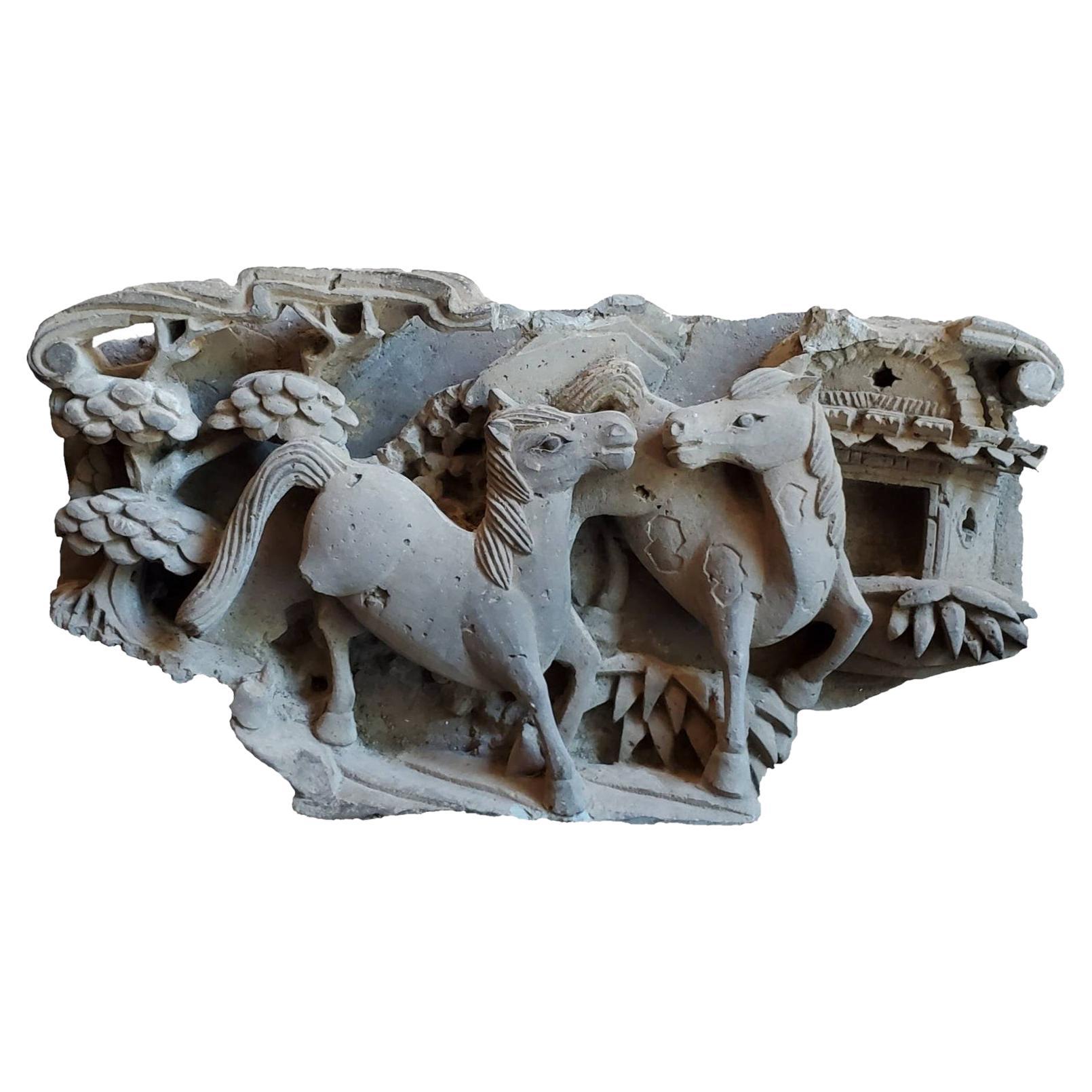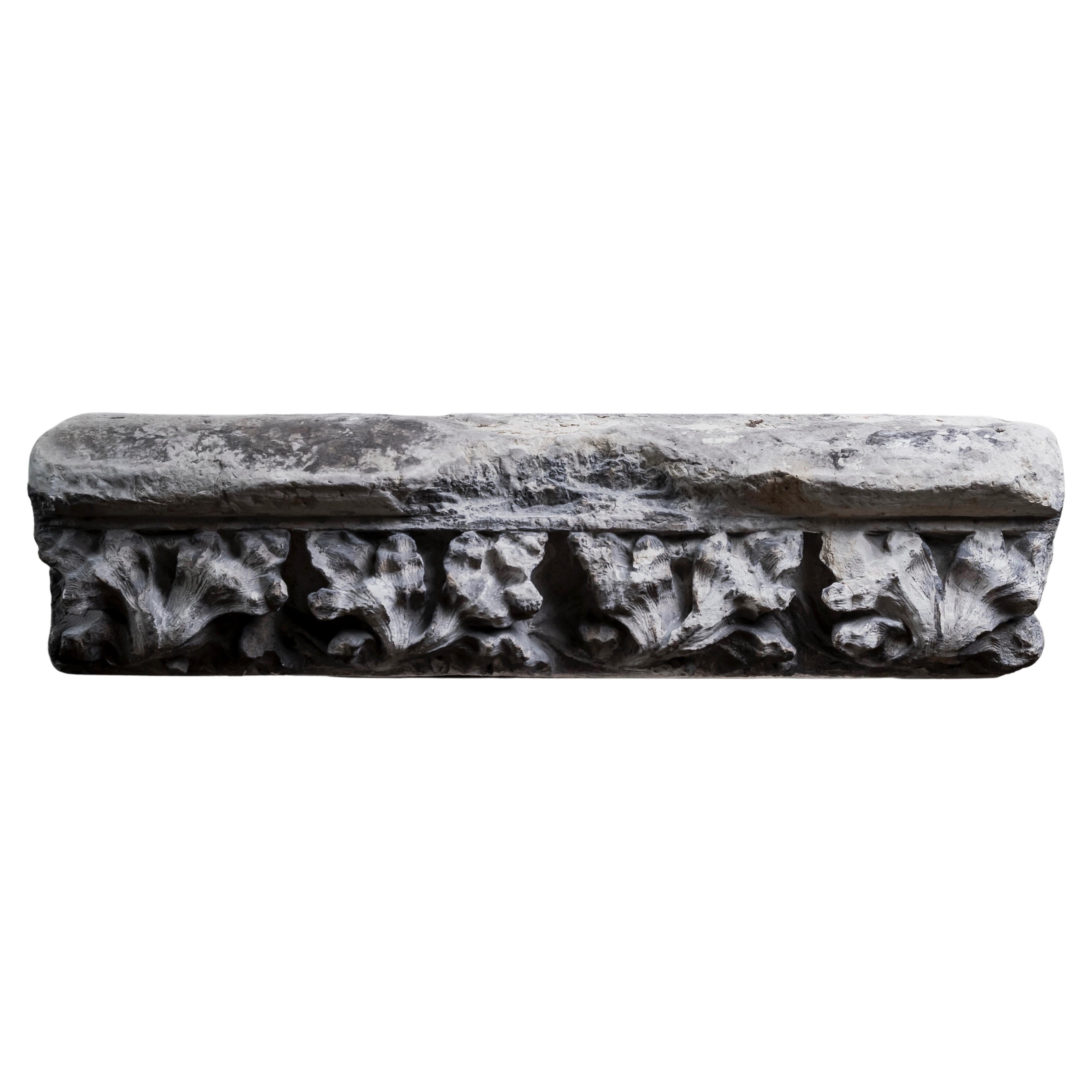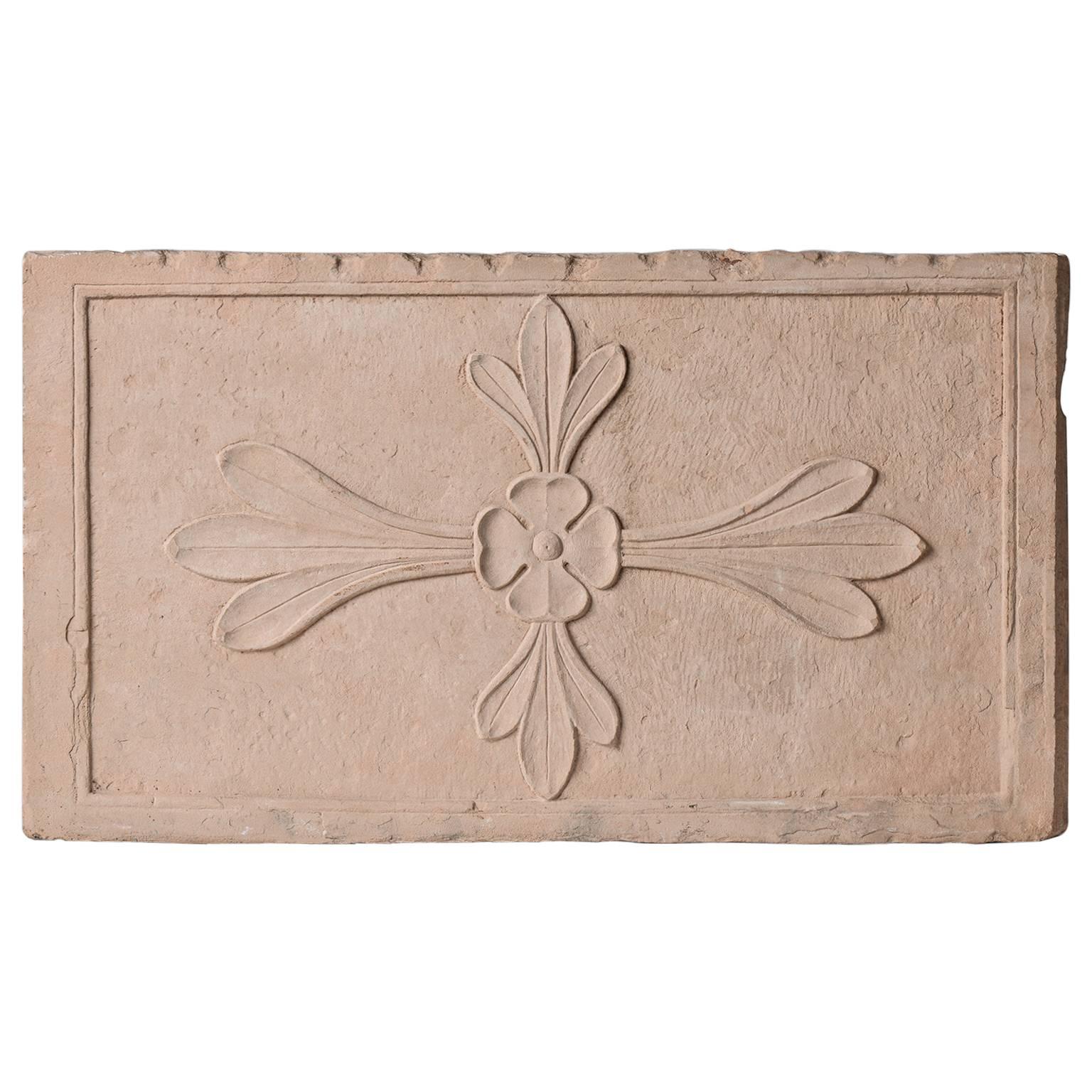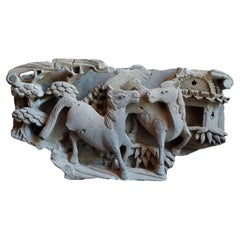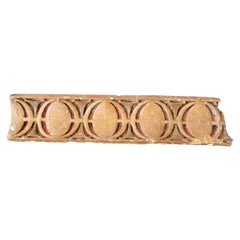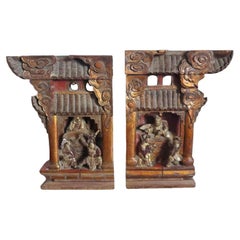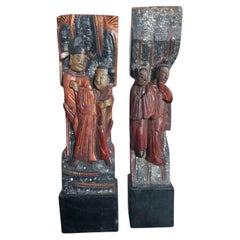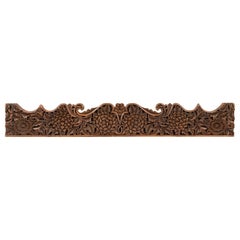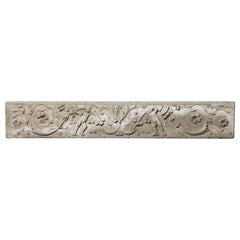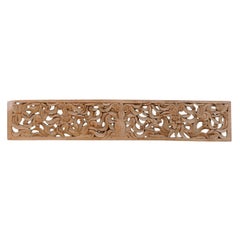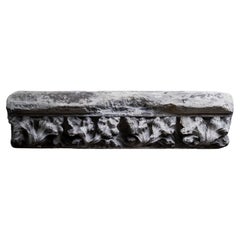Items Similar to Antique Asian Architectural Relief Carved Stone Frieze Panel
Want more images or videos?
Request additional images or videos from the seller
1 of 5
Antique Asian Architectural Relief Carved Stone Frieze Panel
$2,200
£1,666.92
€1,912.66
CA$3,095.76
A$3,403.09
CHF 1,788.51
MX$41,325.87
NOK 22,311.17
SEK 21,138.26
DKK 14,274.63
About the Item
An exceptional architectural high relief hand carved stone band of running scroll decoration frieze panel, with beautiful scrollwork, representing wind or water, and mythological creature, perhaps a dragon or grotesque griffin. The characters in the center may be Asian hieroglyphs (Japanese kanji). The top side has a dovetail joinery cutout from where it would have attached and fit into place before cementing it in place. 19th century or earlier.
This antique architectural salvage building element is a beautiful and artful display of history, and a quick way to add texture, character, rustic charm and interest. Will make a wonderful decorative object within your home or office.
Provenance:
Personal property of Genshiro Kawamoto. A Japanese real estate billionaire and avid art collector who owned numerous multi-million dollar properties in Hawaii and was building one of the most expensive homes in Hawaii prior to his tax evasion arrest, followed by prison sentence in Japan. He had bought multiple properties to convert into museums in order to display his personal decorative arts collection, but due to his legal and financial problems, his items were all auctioned off.
We acquired it in Maui from the dealer that purchased it directly from the estate.
Dimensions: approx
14.5"L, 3"H, 2"D.
- Dimensions:Height: 3 in (7.62 cm)Width: 14.5 in (36.83 cm)Depth: 2 in (5.08 cm)
- Materials and Techniques:
- Place of Origin:
- Period:
- Date of Manufacture:19th Century
- Condition:Wear consistent with age and use.
- Seller Location:Forney, TX
- Reference Number:1stDibs: LU5977226968232
About the Seller
4.8
Platinum Seller
Premium sellers with a 4.7+ rating and 24-hour response times
Established in 2013
1stDibs seller since 2021
296 sales on 1stDibs
Typical response time: <1 hour
- ShippingRetrieving quote...Shipping from: Forney, TX
- Return Policy
Authenticity Guarantee
In the unlikely event there’s an issue with an item’s authenticity, contact us within 1 year for a full refund. DetailsMoney-Back Guarantee
If your item is not as described, is damaged in transit, or does not arrive, contact us within 7 days for a full refund. Details24-Hour Cancellation
You have a 24-hour grace period in which to reconsider your purchase, with no questions asked.Vetted Professional Sellers
Our world-class sellers must adhere to strict standards for service and quality, maintaining the integrity of our listings.Price-Match Guarantee
If you find that a seller listed the same item for a lower price elsewhere, we’ll match it.Trusted Global Delivery
Our best-in-class carrier network provides specialized shipping options worldwide, including custom delivery.More From This Seller
View AllAntique Asian Temple Stone Relief Carved Architectural Element
Located in Forney, TX
A magnificent, rare, one of a kind, ancient Asian temple stone architectural panel, likely frieze fragment. Born in Asia, pre-18th century, most likely mu...
Category
Antique 18th Century Asian Ming Religious Items
Materials
Stone
19th c. Chicago Stock Exchange Building Molding Fragment Architectural Element
Located in Forney, TX
A rare and important hand painted plaster decorative molding fragment, by Louis H. Sullivan (American, 1856-1924), from the interior of the Chicago Stock Exchange, circa 1893-1894.
...
Category
Antique 19th Century American Industrial Architectural Elements
Materials
Plaster, Paint
Rare Set of Two Qing Dynasty Chinese Architectural Temple Brackets
Located in Forney, TX
An original matched pair of exceptionally carved Chinese temple architectural ornaments, the ornate decorative brackets salvaged from an early Qing Dynasty temple, the richy detailed...
Category
Antique Early 19th Century Asian Folk Art Architectural Elements
Materials
Wood, Lacquer, Paint
Pair of Qing Dynasty Chinese Religious Temple Architectural Ornament
Located in Forney, TX
A scarce pair of Qing Dynasty temple architectural ornaments, the decorative antique building element fragments each elaborately hand carved, polychrome painted and lacquered, richly detailed featuring two figural pairs accented...
Category
Antique Early 19th Century Asian Folk Art Architectural Elements
Materials
Mother-of-Pearl, Wood, Lacquer, Paint
19th Century Chinese Temple Architectural Corbel Carved Sculpture Pair
Located in Forney, TX
A majestic pair of antique architectural salvaged Chinese temple corbels, now mounted as one-of-a-kind wooden sculptures on custom floor standing display pedestal stands.
Originally commissioned for an important religious temple in China, the impressive large scale wall bracket corbels were notoriously difficult as they had to serve as both highly decorative temple ornaments and structural building elements used to support the weight of a wall.
Hand-crafted in the early 19th century, smilarly styled design, each exceptionally hand carved, sculpted, and painted by highly trained artisans. Profusely carved and decorated, featuring very fine quality high relief work throughout, extensive bas relief, pierced openwork, rich carvings and intricate incised detailing, depicting various Chinese folk religion figures and imagery.
Rising on bespoke handmade stands, consistenting of sturdy rectangular shaped thick plank plinth base embellished with foliate carvings, held upright by turned column single support.
Rich in culture and history, interesting, unusual, highly decorative, whimsical and artistic, sure to add sophisticated elegance, rustic character, color, space, texture and lots of visual interest.
Dimensions, largest (approx):
Each: 32.5" H, 19" W, 7.25" D.
Please note, the objects were sourced and transported both legally and ethically, retaining partial original red wax export seal to top.
Display the three Sanxing, in their iconic representation as three, old, bearded, wise men, which dates back to the Ming dynasty, when the Gods of the three stars were represented in human form for the first time. One panel having two monumental smiling figures with hand painted eyes and tongue, the other fragment depicting four figures, seated and standing, likely Immortals, Gods, Shen deity, and other characters from ancient Chinese mythology and folklore. Both pieces with elaborate lotus and pine tree motif, a powerful symbol of wisdom and longevity.
Sanxing figures are an important part of Asian culture. Statues of these three Gods...
Category
Antique 19th Century Chinese Chinese Export Architectural Elements
Materials
Wood, Paint
Chinese Ming Dynasty Architectural Terracotta Roof Tile Figure Qilin Foo Dog pr
Located in Forney, TX
A remarkable pair of large Ming Dynasty (1368-1644) earthenware Imperial roof decorations - ornamental architectural terracotta roof tile beasts.
15th/16th century or earlier, Northern China, most likely Forbidden City, Dongcheng District, Beijing, figural pottery modeled as mythical qilin (foo dog / guardian lion), the crouching beast with legs back and flaming body depicted ready to pounce. Retaining partial remnants of the red wax export seal, indicating they are authentic and were legally exported out of the country.
Dimensions: (approx)
Largest: 18" Tall, 19" Wide, 8" Deep
History:
Chinese roof tiles have been a part of Chinese architecture for over 2,000 years. These unique and beautifully crafted tiles have become an integral part of traditional Chinese culture, and have gained international recognition for their beauty and cultural significance. In this article, we will explore the different types of Chinese roof tiles, their construction, cultural significance, preservation and restoration techniques, and modern uses.
Chinese imperial roof decorations or roof charms or roof-figures (Chinese: 檐獸/檐兽; pinyin: yán shòu) or "walking beasts" (Chinese: 走獸/走兽; pinyin: zǒu shòu) or "crouching beasts" (Chinese: 蹲獸/蹲兽; pinyin: Dūn shòu) were statutes placed along the ridge line of official buildings of the Chinese empire. Only official buildings (palaces, government buildings, and some temples) were permitted to use such roof decorations.
Occasionally arranged in an outward marching procession with various different examples, the number and type indicating the importance of the duties performed within the building or within the courtyard protected by a gate. With a maximum number of nine, the mythical beast was one of the highest in rank, thus modeled set to pounce upon the man and lower ranking creatures, ready to devour them should they stray from performing their duties with faithfulness and rectitude
The Design and Construction of Chinese Roofs:
The roof design is an important aspect of Chinese architecture, with each component of the roof playing a specific role. Chinese roof tiles fit into the overall design of the roof and are placed on top of wooden supports called purlins. The interlocking system of Chinese roof tiles ensures that they stay in place and prevent leaks. Ridge tiles...
Category
Antique 16th Century Chinese Ming Sculptures and Carvings
Materials
Earthenware, Terracotta
You May Also Like
Antique Carved Teak Architectural Panel with Floral and Foliage Decor
Located in Yonkers, NY
An antique carved teak architectural panel from the 19th century, with floral and foliage décor. This antique carved teak architectural panel from the 19th century captivates with it...
Category
Antique 19th Century Indonesian Sculptures and Carvings
Materials
Teak
Large Antique Italian Renaissance Style Stone Frieze
Located in Wormelow, Herefordshire
A large antique Italian stone chimney piece frieze dating to circa 1800.
Originally salvaged from a monumental scale fireplace, this frieze displays fine carving in relief depicting...
Category
Antique Early 19th Century Italian Renaissance Architectural Elements
Materials
Stone
19th Century Asian Architectural Transom Panel with Pierced Carved Foliage
Located in Atlanta, GA
19th Century Asian Architectural transom panel with pierced carved foliage.
Category
Antique 19th Century Asian Architectural Elements
Materials
Wood
Large Medieval carved frieze - France, 14th-15th century
Located in Bruxelles, BE
Gothic Limestone frieze decorated with curly foliage
North of France, 14th-15th century
59,8 x 15,6x 22 cm
This French Gothic limestone frieze, adorned with curling foliage, stands ...
Category
Antique 15th Century and Earlier French Medieval Architectural Elements
Materials
Limestone
$2,601 Sale Price
20% Off
Architectural Antique Stone Panel -
Located in Alessandria, Piemonte
Charming antique Mogul cast pink stone, special for an architectural solution - wonderful on wall like a sculpture or on a base for little table. It's a rare piece, perfectly preser...
Category
Antique Mid-18th Century Indian Agra Sculptures and Carvings
Materials
Sandstone
Large Antique Indian Carved Marble Lintel
Located in London, GB
Large antique Indian carved marble lintel
Indian, 18th century
Measures: Height 83cm, width 170cm, depth 22cm
Finely carved in white marble, this sculpture is a wonderful example of Indian Buddhist sculpture. It portrays a Dharma wheel with two deer either side, which is a common composition in Indian, Nepalese and Tibetan Buddhist architecture.
The Dharma wheel, a common motif in Buddhist art, is often used as a decoration in temples, representing the Buddha’s teaching...
Category
Antique 18th Century Indian Architectural Elements
Materials
Marble
More Ways To Browse
Antique Frieze
Carved Relief
Relief Panel
19th Century Carved Panel
Hawaiian Antique
Antique Building Salvage
Stone Relief
Relief Frieze
Hand Carved Frieze
Stone Frieze
Carved Stone Relief
Carved Stone Panel
Garden Trellis
Antique Black Limestone
Antique Garden Mirrors
European Architectural Antiques
Antique Iron Bell
Belgian Antique Tiles
